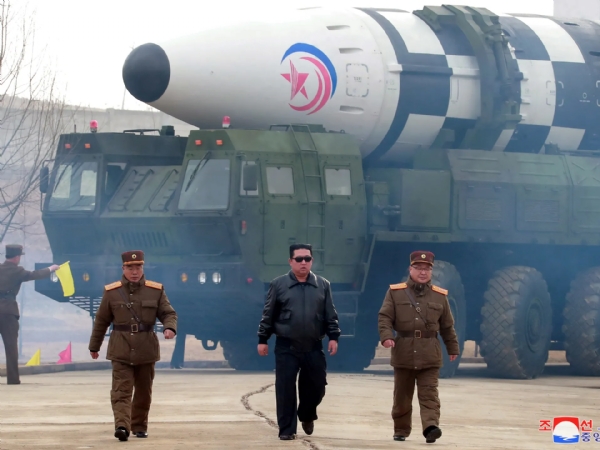#SecurityScan 95 : China's Strategic Canal Project, the Ream Naval Base & much more
Japan"s white paper on security describes the current security situation as the most severe and complex since the end of World War II.
Total Views |
This article is a summary of important events that have taken place in last one week affecting, India's national security.
NEWS IN BRIEF
Paralympic Champions: India's Real Heroes
Overcoming Adversity
Dharambir, Harvinder Singh, Nitesh Kumar, Sumit Antil, and Avani Lekhara are names that may not be as familiar as those of India's cricketers. However, their achievements are equally, if not more, remarkable. These athletes have conquered immense challenges to stand on the highest podium of the Paralympic Games.

Defying the Odds
Harvinder Singh, an archer from Haryana, was struck by dengue as a toddler, leading to impaired legs. Despite his disability, he pursued his passion for archery and became the first Indian archer to win a Paralympics gold. Similarly, Dharambir, also from Haryana, was paralyzed after a diving accident but defied the odds to become a club throw champion. Sumit Antil and Avani Lekhara, both from road accidents, have also risen to the top of their respective sports.
The Need for Recognition
Unfortunately, the Paralympic Games do not garner the same level of attention in India as the Olympics. Para-athletes are often overlooked and not considered "real" athletes. This attitude needs to change. While Sports Minister Mansukh Mandaviya has called for greater support for Paralympic athletes, more needs to be done to promote and celebrate their achievements.
A Call for Change
It's time to recognize the incredible feats of our Paralympic champions. Their stories of resilience and determination inspire us all. By supporting para-athletes and raising awareness about the Paralympic Games, we can foster a more inclusive and equitable sporting culture in India.
Rallying in Solidarity: Lessons from Bangladesh Hindus
A group of Hindu students at the University of California, Berkeley, recently organized a poignant candlelight vigil in Sproul Plaza to honor the victims of anti-Hindu violence in Bangladesh. This gathering not only served as a powerful message of solidarity but also offered crucial insights for threatened Hindu communities worldwide.
Unveiling Western Media Complicity
During the vigil, discussions repeatedly touched upon the role of Western media in either diminishing or overlooking violence against Hindus. Speakers drew parallels to historical media failures, emphasizing the urgent need to speak out against such atrocities despite the prevalent culture of denial and indifference.
Denial Breeding Genocide: A Stark Reality
Despite heightened awareness of Hindu persecution via social platforms, a stark reality persists: many Hindus struggle to combat the entrenched denial of their suffering by influential societal institutions. Governments, NGOs, corporations, universities, and the media often turn a blind eye to anti-Hindu violence, perpetuating a cycle of dismissal and apathy.
The Perils of Seeking Validation: A Cautionary Tale
The shift towards downplaying religious and cultural identity in favor of emphasizing economic accomplishments has inadvertently cast Hindus in a defensive light. This stance risks diluting the profound spiritual essence of Hinduism, potentially enabling detractors to undermine its significance.
Embracing Tradition for Resilience
To ensure the longevity of Hinduism, a return to its spiritual core is imperative. Upholding a steadfast connection to ancestral traditions and deities is key, transcending the need for external validation. By fortifying their spiritual heritage with conviction, Hindus can better navigate the challenges and threats on the horizon, drawing strength from their profound traditions.
India's Export Challenges-Economic Growth Amidst Global Pressures
The World Bank has revised its growth forecast for India's economy upwards, reflecting its resilience in the face of global challenges. However, the report highlights a concerning trend: India's declining share in global exports compared to competitors like Vietnam and Bangladesh.
Losing Ground in Key Sectors
India's exports of apparel, leather, textiles, and footwear have decreased significantly over the past decade. This decline is particularly evident when compared to the growth of Bangladesh and Vietnam in these sectors. Furthermore, India's trade deficit with China continues to widen, indicating a strong preference for Chinese goods in the Indian market.
Opportunities and Challenges
Despite these challenges, India has an opportunity to regain lost ground due to political and economic instability in Bangladesh. To achieve this, India must focus on reducing production costs, improving productivity, and maintaining quality standards. While India has been hesitant to join large trade blocs, bilateral Free Trade Agreements with Western and Gulf nations can be a strategic approach to countering the competition from Vietnam and China.
Conclusion
India's economic growth is commendable, but its export performance requires urgent attention. By addressing the challenges of high production costs, improving productivity, and strategically engaging with global markets, India can enhance its competitiveness and achieve its ambitious export goals
#COUNTERING CHINESE MULTI DOMAIN , GREY ZONE, HIGH BREED WARFARE
US-Australia-Japan Trilateral Cooperation on Strategic Stability Against China
The launch of the CSIS Australia and Japan Chairs Report on U.S.-Australia-Japan Trilateral Cooperation highlights the growing importance of strategic stability in the Taiwan Strait. China's escalating military activities, economic pressure, and increasingly belligerent rhetoric regarding reunification have significantly heightened tensions, both regionally and globally. The risk of conflict in the Taiwan Strait has become a pressing concern, with potential scenarios ranging from a full-scale invasion to more ambiguous forms of aggression that fall below the threshold of conventional warfare.
The Role of the U.S., Japan, and Australia
The United States, Japan, and Australia serve as the primary anchors of regional stability in the Indo-Pacific. Despite the formidable power and shared interests of these three nations in maintaining cross-strait stability, discussions between Washington, Tokyo, and Canberra on preventing and responding to a crisis remain underdeveloped. There is a critical need for enhanced dialogue and coordination among these allies to effectively address the challenges posed by China's assertive actions.
Track 2 Discussions for Strategic Stability
In an effort to foster a more focused dialogue on preserving cross-strait stability, the CSIS Australia Chair and Japan Chair convened a group of 22 leading strategic thinkers from the United States, Japan, and Australia for two days of Track 2 discussions in Canberra. These discussions were marked by vigorous debate on the best strategies to counter China's grey zone coercion and to strengthen deterrence against any potential use of force by China to compel unification. The outcomes of these discussions are expected to play a crucial role in shaping future trilateral cooperation on strategic stability in the region.
Strategic Focus on Border, Coastal, and Air Defense: Xi Jinping's Military Priorities
China's national defense strategy places a significant emphasis on safeguarding its territorial sovereignty and maritime rights, particularly through robust border, coastal, and air defense mechanisms. In a recent speech, Xi Jinping underscored the importance of mainland defense, signaling a strategic priority that reflects Beijing's broader geopolitical concerns.
Strengthening Traditional Combat Forces
Xi Jinping's emphasis on border, coastal, and air defense aligns with the Chinese Communist Party's resolution. In Chinese military terminology, "traditional combat forces" typically refer to conscript-heavy units, which include border and coastal defense forces and other ground combat units. By prioritizing homeland defense, Xi is likely to elevate the stature of these army elements, enhancing their profile within society.
Implications for Local Governments and Military-Civilian Integration
A pertinent example of this trend is the construction of over 50 new villages and the expansion of 100 others in remote regions along China's periphery since 2016, likely driven by this policy direction.
A New Front in the Indo-Pacific: The Gulf of Thailand

China's Strategic Canal Project
The geopolitical tensions between China and the United States have intensified in the South China Sea and Taiwan Strait. However, another significant body of water in the Indo-Pacific, the Gulf of Thailand, is emerging as a potential flashpoint. China's ambitious infrastructure projects in the region, particularly the Funan-Techo Canal, could significantly alter the regional balance of power.
The Funan-Techo Canal: A Game-Changer
The Funan-Techo Canal, a $1.7 billion project funded by China, aims to connect Cambodia's capital, Phnom Penh, to the Gulf of Thailand. This canal, if completed, could reduce shipping times and boost Cambodia's economy. The project is touted as a win-win for both Cambodia and China .
China's Strategic Objectives
China's investment in the canal serves several strategic objectives. Firstly, it grants China direct access to the Gulf of Thailand, bypassing the need to navigate through the South China Sea. This could potentially reduce the risk of confrontations with other regional powers. Secondly, the canal could help China address its "Malacca Dilemma," a concern about its dependence on the Strait of Malacca for trade. Finally, the project could give China a strategic advantage over Vietnam, a regional rival.
Implications for Regional Stability
The Funan-Techo Canal project could potentially escalate tensions between China and other regional powers, particularly Vietnam.
China's Expanding Maritime Footprint: A Growing Security Threat
Global Port Investments: A Strategic Advantage
China's strategic investments in ports around the world have significantly expanded its maritime footprint. While these investments offer economic benefits, they also pose security threats and potential disruptions to global trade. China's rivals must remain vigilant and address these concerns.
The Ream Naval Base: A Strategic Asset
The Ream Naval base in Cambodia, a Chinese-backed project, is a particular cause for concern. Its location on the Gulf of Thailand provides China with strategic access to crucial shipping lanes in the South China Sea. This development could further escalate tensions in the region as China continues to assert its claims over the disputed waterway.
The Sabina Shoal: A New Flashpoint in the South China Sea
Escalating Tensions Between China and the Philippines
The South China Sea continues to be a hotbed of tension, with recent clashes between China and the Philippines highlighting the ongoing dispute over territorial claims. The Sabina Shoal, a coral atoll off the Philippines coast, has emerged as a new flashpoint, despite recent efforts to de-escalate tensions in other areas.
A Dangerous Game of Brinkmanship
While neither China nor the Philippines appears to be seeking a military confrontation, their actions in the South China Sea are a dangerous game of brinkmanship. The ongoing disputes over territorial claims and resource-rich waters pose a significant threat to regional stability. It is imperative for all parties involved to engage in constructive dialogue and find peaceful solutions to these complex issues.
India-Singapore Ties: A Classic Win-Win Case
Prime Minister Narendra Modi’s visit to Singapore has provided new strategic direction to the steadily growing relationship between India and Singapore. Today, this relationship is marked by economic cooperation, strategic alignment, and emerging opportunities in various sectors.
Strengthening Economic Foundations: Singapore as a Financial Anchor

Singapore's economic engagement with India has surged over the past two decades, with investments totaling $160 billion, making Singapore India's largest source of Foreign Direct Investment (FDI). Notable initiatives like CapitaLand's decision to double its funds in India underscore Singapore's pivotal role as a financial anchor. The robust trade relationship, with Singapore as India's sixth-largest trading partner, reflects the mutually beneficial nature of their economies.
Fostering Strategic Alliances: India-Singapore Defense Cooperation
Beyond economic collaboration, India and Singapore share strategic interests, particularly in response to China's regional assertiveness. Defense cooperation, exemplified by the annual SIMBEX naval exercise, stands as a cornerstone of their partnership. There are talks of India considering a long-term Navy deployment in Singapore, akin to its Air Force presence in Japan, leveraging Singapore's strategic location and defense capabilities to bolster India's naval strength and potentially enhance defense exports.
Diversifying Cooperation Horizons: Exploring New Frontiers
The India-Singapore relationship is expanding into novel domains like health and semiconductor technologies, while financial integration deepens with Indian companies increasingly listing on the Singapore Stock Exchange. Singapore serves as a conduit for Indian businesses seeking global capital, while opportunities in Gujarat's GIFT City offer new avenues for Singaporean investments. This diversification heralds a new era of collaboration, positioning Singapore as a key partner alongside Japan in India's strategic landscape.
China's Growing Obesity Crisis
Economic Hardship and Unhealthy Lifestyles
China is facing a significant obesity epidemic, driven by a combination of economic factors and unhealthy lifestyle choices. The slowdown in construction and manufacturing sectors has led to financial difficulties for many, forcing them to opt for cheaper, less nutritious food options.
Job Stress, Sedentary Lifestyles, and Poor Diets
The shift towards desk-bound jobs, long working hours, and increased stress levels have contributed to rising obesity rates in urban areas. Meanwhile, automation in agriculture and limited healthcare access have exacerbated the problem in rural regions.
The Impact on Children
The economic downturn has also affected children's health, as parents cut back on sports classes and extracurricular activities. This decline in physical activity, coupled with increased consumption of unhealthy snacks, has contributed to rising childhood obesity rates.
JAPAN WHITE PAPER ON SECURITY-Growing Concerns Over Chinese Posturing
Japan has issued a stark warning about the deteriorating security environment in the Asia-Pacific region, highlighting the increasing threat posed by China's military expansion and territorial claims. The annual white paper released by Japan's defense ministry emphasizes the urgency of addressing these challenges to maintain regional stability and global peace.
A New Era of Crisis
The white paper describes the current security situation as the most severe and complex since the end of World War II. Japan's defense minister, Minoru Kihara, warns that the international community is facing a "greatest trial" and that the existing international order is under unprecedented threat.
China's Rising Influence
The white paper specifically highlights China's rapid military buildup and its increasingly assertive behavior in the East China Sea, South China Sea, and the broader Pacific region. Japan expresses concerns about China's territorial claims, particularly around the Senkaku Islands, and the potential for conflict in the region.
North Korea's Nuclear Threat and Russia's Aggression

In addition to China, the white paper also addresses the threats posed by North Korea's nuclear and missile programs and Russia's intensified military activities in the Far East. Japan emphasizes the need to counter these threats and maintain regional stability.
The Impact on Global Peace
Japan's defense ministry warns that the current security challenges have the potential to severely disrupt global peace and stability. The country's efforts to strengthen its defense capabilities are not only aimed at securing its own national security but also at preserving the broader international order.
China's Assertiveness in the Region
The white paper highlights China's attempts to alter the status quo in the region through force, particularly in the East China and South China Seas. Japan fears that an armed conflict over Taiwan could have serious consequences for the region.
The South China Sea Dispute
China's sweeping claims of sovereignty over the South China Sea, a region rich in natural resources, have led to conflicts with several other countries. The failure to resolve these disputes through diplomacy has increased tensions and fueled an arms race in the Pacific.
Japan's Strategic Response
To address the growing security threats, Japan is reinforcing its defense capabilities, acquiring new military equipment, and strengthening alliances with like-minded countries. The country is also prioritizing cooperation with the United States and other partners to promote the "Free and Open Indo-Pacific" vision.
Conclusion
Japan's white paper serves as a stark reminder of the increasing tensions and challenges facing the Asia-Pacific region. The country's efforts to strengthen its defense capabilities and promote regional cooperation are essential for maintaining peace and stability in the face of growing threats.
China's Shifting Strategy in Africa: A Focus on Returns
A Decade of Lending and Influence
China's Belt and Road Initiative has significantly increased its economic presence in Africa through substantial government-backed loans. These investments have helped China secure access to resources and expand its influence on the continent. However, as the challenges of debt sustainability become more apparent, China is now seeking to shift its strategy.
A New Approach: Commercial Loans and Higher Returns
As African countries face growing debt burdens, China is proposing a new approach: commercial loans that could offer higher returns. This shift reflects China's desire to maximize its economic benefits while minimizing risks. The upcoming meeting between Chinese President Xi Jinping and African leaders will be a crucial opportunity to discuss these new proposals and explore potential partnerships.
WORLD AT WAR:LESSONS FOR INDIA
Managing Escalation with Nuclear Adversaries Like China
The United States is grappling with the pressing need to craft a comprehensive theory of victory that delineates strategies to emerge successful in a potential conflict with China while sidestepping the specter of nuclear warfare.
Imposing Costs: Striking the Delicate Balance
An alternative strategy involves inflicting severe repercussions on China beyond the immediate theater of Taiwan. Possibilities include establishing a naval blockade or targeting crucial Chinese industrial sites aiding the war effort. The objective is to persuade Chinese leadership that the war's continuation comes at an exorbitant price, compelling them to reconsider their stance.
The Goldilocks Challenge: A Strategic Tightrope
This strategy poses what RAND analysts have labeled the "Goldilocks challenge." As per a recent study commissioned by the U.S. Department of the Air Force, the dilemma lies in exacting costs significant enough to dissuade China while evading a catastrophic escalation, such as a retaliatory missile strike on U.S. soil. The calibration of costs must be precise—too lenient and China may absorb them as a routine wartime expense; too severe and the situation could hurtle towards nuclear confrontation.
Denial Redefined as the Optimal Path
Despite the intricate nature of the Goldilocks challenge, experts have deduced that the most viable strategy remains denying China any glimpse of victory from the outset. Although fraught with hurdles, the U.S. boasts critical advantages like its submarine fleet and long-range missile capabilities, rendering a potential Chinese assault on Taiwan excessively perilous.
Navigating the Unpredictability of Escalation
The landscape of managing escalation is riddled with fundamental uncertainties. Even Chinese President Xi Jinping may find himself uncertain about his responses in the heat of the moment. This unpredictability underscores the paramount importance of meticulous and strategic planning in any confrontation with a nuclear-capable opponent such as China.
--


